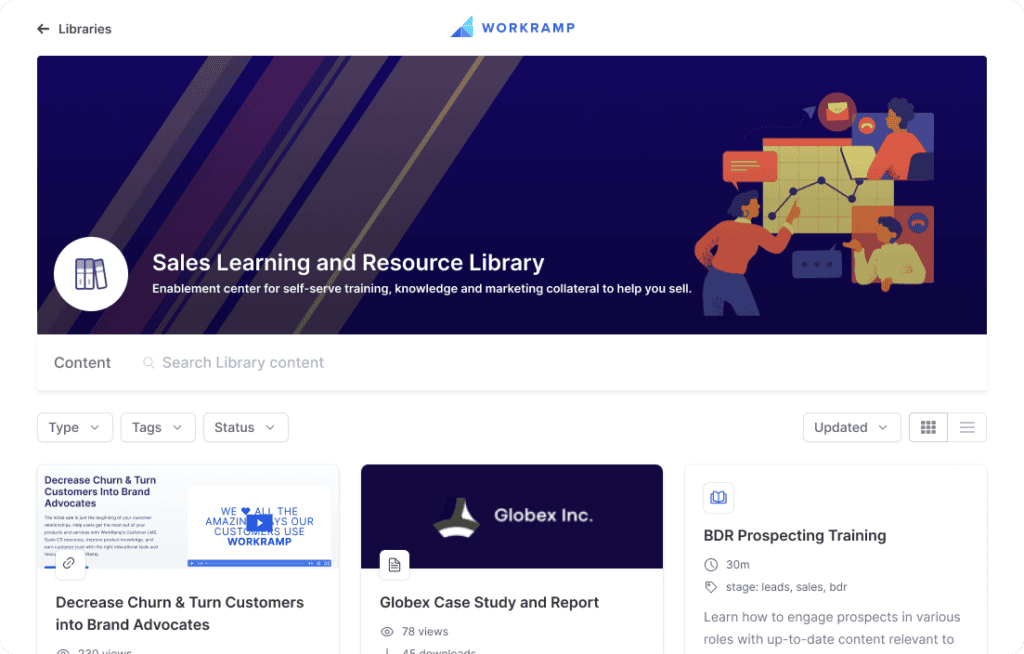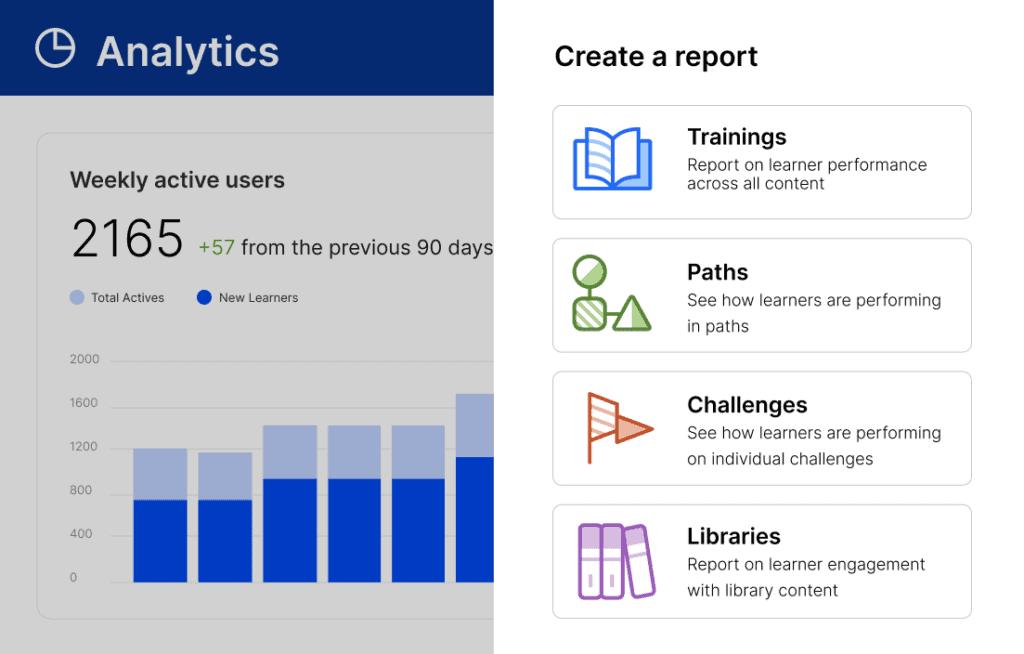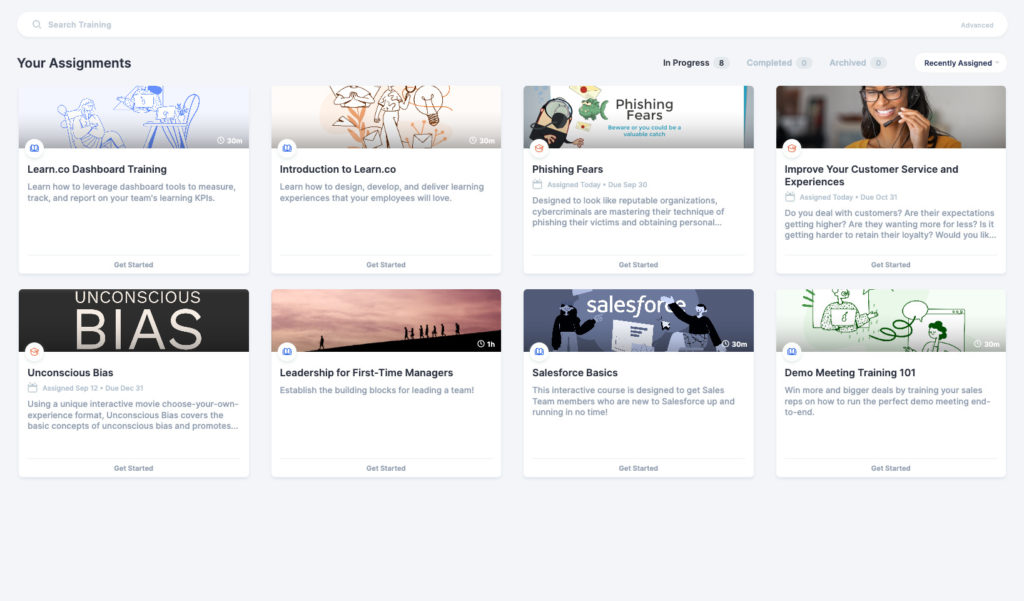9 Must-Have LMS Modules for eLearning in 2024
Anna Spooner | WorkRamp Contributor
View bioLearning Tips Straight to Your Inbox
Learning and development (L&D) is no longer a nice to have. It’s a must-have element for successful organizations and essential to promote continuous improvement and maintain a competitive advantage.
The top four focus areas for L&D are aligning learning to business goals, upskilling employees, creating a culture of learning, and improving employee retention, according to a recent Workplace Learning Report.
How do you meet these goals? You need the right learning management system and LMS modules that support your objectives, from quickly building relevant skills to reskilling employees for new opportunities.
Knowing which features and modules to look for is essential in making the decision to invest in an LMS platform for your L&D program. Discover which modules are important and how to use them to maximize the impact of your training programs.
Read more: What is an LMS? A Guide to Learning Management Systems
In this post:
LMS module meaning
What is an LMS module? It’s a feature or part of a learning management system that’s either built-in or available through integrations with other software.
LMS modules let you create specific courses, deploy training in certain ways, and track results regarding completion rates and impact on employee performance.
LMS modules make using the platform easier and more intuitive, improving the experience for learners and admins.
LMS modules to know
So, which LMS features are the most important of the options available?
You can start by focusing on the modules that impact the core of your learning and development program—course creation, learner experience, and reporting. Then, look at features that make training courses more engaging and help you create a learning culture, such as interactive elements and various file types in training programs.
Course management
Course management allows your L&D team to create training courses natively in the LMS rather than using an external tool or paying for expensive add-on software.
Course management is closely linked to content management because the content your team uses to create training sessions can also be stored and organized with your LMS if you choose the right solution.

For example, the Learning Cloud from WorkRamp offers a unified LMS + CMS on a single platform. This gives employees and admins a one-stop shop for sales materials and learning content.
With the Learning Cloud, your team can create engaging learning experiences with multiple file types that cater to various learning styles. No more headaches or wasted time transitioning courses from a course management system to your LMS.
User and roles management
Having appropriate user roles allows the right people in your organization to access the appropriate information. This helps ensure security and compliance when accessing proprietary information.
Also, the right user management tools allow personalized training plans for learners, which can improve engagement and help individuals learn the skills they’re most interested in. It’s also helpful when assigning training because courses can be assigned to user groups instead of individually to each learner.
Finally, user and role management allows an LMS to be the foundation for multiple training programs, such as sales enablement, new hire onboarding, and customer education. By having specific user experiences, you can ensure every learner group has an engaging, intuitive experience that fits their needs.
Learning delivery methods
How do your employees, customers, and partners prefer to receive training? The answer may surprise you—a 2022 SHRM report found that 70 percent of employees liked online training, 63 percent liked instructor-led online training, 63 percent liked in-person training, and 62 percent enjoyed hybrid training.
These results show there’s no single best learning delivery method, so it’s important that your LMS has the ability to provide a variety of delivery methods. The Learning Cloud makes it easy to provide on-demand online courses, instructor-led training, and hybrid or blended learning.
Having the flexibility to offer various learning experiences makes it easier for learners to retain new information and practice new skills.
Reporting and analytics

The only way to know the impact of your L&D team’s training is by measuring results, so you need a robust reporting and analytics module in your LMS.
Here are some things to track:
- Training completion rates and where learners drop off
- What courses are the most and least popular
- Results of post-training exams and assessments
- Trainer and learner satisfaction and feedback
- How training results correlate with performance results
- How training programs correlate with improvements in the company’s revenue, profitability, productivity, and turnover
One key to successful measurement is to ensure the LMS integrates with other parts of your tech stack so you can compare training results to ongoing performance, employee turnaround, and more.
The Learning Cloud offers reporting tools to help you measure the impact of your learning programs. You can also use Reporting APIs to push training data into other systems to report back to company leaders.
Learner portals
The learner experience is centered around the landing page they see when they log in, also known as the learner portal. In a great LMS, this page will reflect the learner’s role or user group, interests and personal learning tracks, and progress in current training programs.
The portal should be intuitive and easy to use. Learners should be able to find specific training courses and discover new learning opportunities. Also, your team should be able to customize the portal depending on the learner group—customers, new hires, employees, and sales reps all see different dashboards that are appropriate for their needs.

If the learner portal isn’t customizable or is difficult to use, the learning experience will be poor, which leads to low buy-in and decreased training completion. It’s essential to get an LMS with an easy-to-use, personalized interface.
Online assessments
Online assessments are essential to measure how well a learner understands and retains new information. That doesn’t mean they have to be dull! The best LMS platforms offer a variety of ways to assess learning both during and after a course, from games to quizzes to interactive simulations.
Beyond being engaging, assessments also need to tie into analytics software that allows your teams to run reports and understand the overall effectiveness of each training program. Some LMS reports are built into the platform, while others require specific software integration.
An excellent LMS will also use assessment results to recommend follow-up courses to learners to either build on their knowledge or reinforce an area they scored lower on.
Mobile learning
Many of today’s learners are on the go, whether employees working on career skills, customers learning your product or service, or reps getting sales training. That means that having an LMS with a mobile learning module is essential.
Mobile learning is perfect for microlearning, allowing users to break training into bite-sized, digestible pieces they can complete on demand. It also increases the flexibility and convenience of learning, which means more users will participate.
Learning in short timeframes at convenient times increases engagement and motivation among learners as well. A mobile learning module makes your training program far more accessible and effective.
Gamification
Gamification allows you to incorporate game-like elements into training, such as earning points or badges.
You can also use flip cards and interactive quizzes to test learners’ knowledge, show a leaderboard of course assessment results, or create levels within the training module to offer the feeling of an immediate win as learners progress.
Communication and collaboration tools
Finally, it’s important to have communication and collaboration tools available within the LMS. Collaboration tools make it easy for the L&D team to stay on the same page as they build courses, eliminate duplicate work, and ensure that the courses align with the company’s overall goals.
Communication tools also make it easier for managers to schedule training for their teams, for learners to receive reminders about courses, and for learners to collaborate during live or hybrid training. As a result, training is deployed more efficiently, and it’s easier to get the results the organization is looking for.
The Learning Cloud offers LMS integrations with communication tools like Slack and Microsoft Teams.
Additional LMS aspects to look for
What else should you look for when considering options for a learning management system?
There are other features beyond the modules mentioned above that can make an LMS easier and more impactful for everyone.
Customization
The best tools do exactly what you need them to do, and when it comes to an LMS, that means it needs to be customizable to your needs.
Also, the right LMS will be simple to customize to match your brand. From color settings to ensuring your logo and other key brand elements are part of every learner’s portal, you want to ensure a seamless experience for every employee, customer, and partner.
Ease of use
An LMS can have every feature you’ve ever dreamed of, but if it isn’t easy to use, those features won’t help your organization reach its goals. A platform intuitive for learners and admins will help ensure the company gets maximum ROI from its investment.
The Learning Cloud offers an intuitive, easy-to-use interface and drag-and-drop course creation tools to make it simple for learners and admins to use the platform and for new users to get up and running quickly.
Deployment method
It’s essential for today’s workplace to deploy training programs in multiple ways. Employees may want to access training on their cell phones, work laptops, or in person. It’s vital to have an LMS that supports all of these options
The Learning Cloud supports on-demand learning, hybrid training, and instructor-led training, making it a great foundation for your L&D program.
Integration opportunities
A great LMS should integrate with the rest of your tech stack. This helps your team be more efficient and gives team members access to the data they need.
The Learning Cloud offers robust LMS integrations with commonly used tools like BambooHR, Zoom, Google Calendar, Gong, Salesforce, and more.
Security
The training your organization offers is proprietary, and it’s essential that the information is protected. Having ample security in your LMS, especially when employees are accessing training remotely, is essential.
Security works best when it’s as automated as possible, so consider having a Single Sign On (SSO) process, two-factor authentication, and carefully defined user roles.
Benefits of implementing a learning management system
An LMS makes training much more effective and efficient. There are a variety of other benefits as well.
Time and cost optimization
The time it takes to create a training course without an LMS is significantly longer than with one. The time—and, by extension, money—an organization spends on training will be far more effective when you have the right foundation for the program.
Deploying training is also far more difficult and time-consuming without an LMS. Having the right platform gives users on-demand access to resources to complete training when it’s most convenient for them.
Streamlined content management
An LMS with content management tools allows you to manage and organize training assets. Not all LMS platforms have a CMS, so you must prioritize it on your features list.
A unified LMS + CMS, like WorkRamp, helps your team save time with searchable assets, allows your sales reps to access the sales collateral they need when they need it, and significantly speeds up training development and delivery.
Demonstrable ROI
How do you prove that the training program makes a difference in employee performance, engagement, and bottom-line company results?
If you don’t have an LMS, it’s very difficult. However, an LMS with the right integrations and reporting features allows you to show the impact of each training program to company leaders and get buy-in for your L&D program.
Improved retention and engagement
A training program that is easy for employees to access and complete makes all the difference in employee engagement and retention. Employees value an organization that invests in their growth and development, which shows in productivity and turnover. Having an LMS allows you to create engaging, impactful training experiences.
Some LMSs also allow your company to create customer training programs, which help improve product adoption and customer satisfaction and reduce churn. With an all-in-one LMS like the Learning Cloud, you can offer employee and customer training on a single platform.
Access the best LMS modules
The right LMS modules and features can help you get the most impact from your training programs.
Discover how the Learning Cloud can help you create and deploy engaging, impactful training programs. Contact us to schedule your free, personalized demo.
Complete the form for a custom demo.
Recent Posts
- How to Drive Revenue Growth with Sales Enablement October 21, 2024
- 8 Best Salesforce Learning Management Systems (LMS) October 8, 2024
- 5 Steps to Create a Winning Sales Communication Strategy September 30, 2024
- WorkRamp’s Nine-Year Anniversary in Photos September 24, 2024
- WorkRamp Cover Story: Enabling Organizational Change at Sprout Social September 23, 2024
Anna Spooner
WorkRamp ContributorAnna Spooner is a digital strategist and marketer with over 11 years of experience. She writes content for various industries, including SaaS, medical and personal insurance, healthcare, education, marketing, and business. She enjoys the process of putting words around a company’s vision and is an expert at making complex ideas approachable and encouraging an audience to take action.
You might also like
Select the right tool for your L&D initiatives & get the most value from the platform you choose
Discover key LMS best practices for 2024 to ensure a smooth rollout and maximum engagement.
Read More
Create engaging eLearning content for your teams
eLearning gives organizations the flexibility that other online courses can offer, but creating courses that are engaging and impactful can be harder than you think.
Read More
Find the best LMS to empower employees, customers, and partners
Learning management systems, or LMSs, are an indispensable tool for increasing team productivity and effectiveness. But with multiple platforms, the key lies in choosing the right one, as not all LMS are created equal.
Read More
Ready to Explore Online Learning Platforms?
Get in touch to learn how WorkRamp can help you achieve your training goals.
Request a Demo




